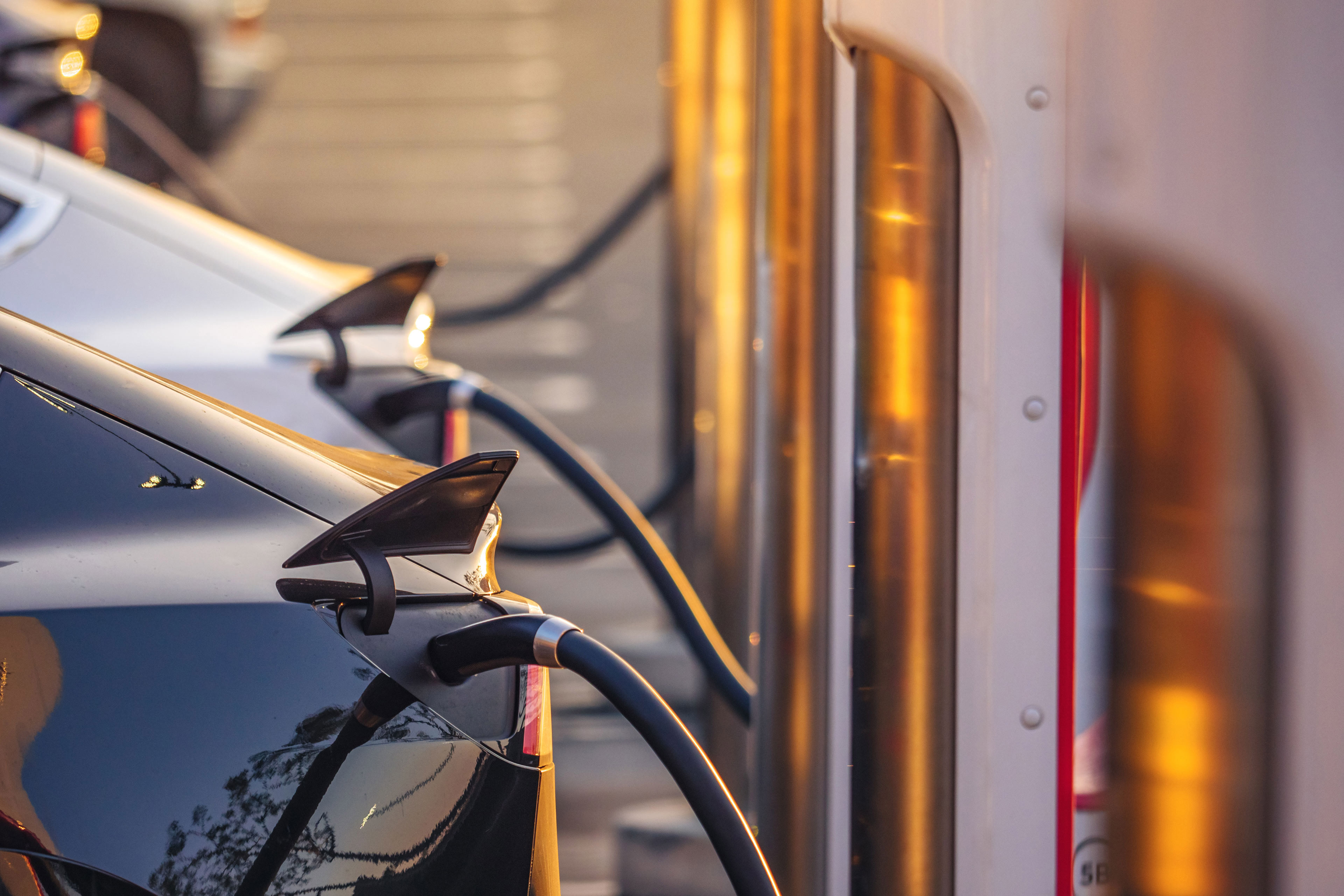EY refers to the global organization, and may refer to one or more, of the member firms of Ernst & Young Global Limited, each of which is a separate legal entity. Ernst & Young Global Limited, a UK company limited by guarantee, does not provide services to clients.
Clarifying the EV equation from abstraction into action
A telco has one of the biggest corporate fleets in the US. Would the math support an EV transition — or were the variables too complex?
The better the question
Can we build a future while awaiting the roads to get there?
The business case for electrifying corporate fleets has grown more compelling — and more complex.
As the pressures from climate change continue to intensify, electric vehicles (EVs) present an intricate balance of opportunity and complexity for companies with large corporate fleets. For one US telco with about 25,000 service vehicles, the equation to determine the return on investment was especially difficult.
Replacing their existing fleet of gas-engine vehicles with EVs would go a long way toward meeting the company’s emissions-reduction commitments. And to some extent, the economics supported making the change. Further, governments are adding urgency through regulations and incentives: the US and Canada have targeted 2040 for all their commercial trucks to become electric. And automakers are coming out with dozens of EVs over the next decade — while eventually phasing out gas-engine vehicles altogether. The cost of EV batteries continues to plummet, and EVs require much less money to maintain (as there are no oil changes, for example). One executive who upgraded his company’s fleet said that the cost savings per vehicle totaled about $10,000 to $12,000 per year thanks to fuel and maintenance savings, in an article for The New York Times.1
Yet profound questions remain about where EVs can be reliably recharged, and for how much. For the telecom giant, their service vehicles did not go to a depot at the end of the day, where chargers could be installed — they went to the drivers’ homes. Could EVs be plugged in there, which would require at-home charger installations? Who would then own that equipment? Would it need to be returned upon employee separation? What about employees who live in rental homes, apartments or homes without the electrical compatibility for EV chargers? Should the company build its own charging network? Or what could it do while waiting for the supporting public infrastructure to be developed — and how could it not get too ahead of where it will be accessible? These questions all had different answers across the company’s vast and diverse geographic footprint.
Developing a model that would assess relevant operational and financial factors within each geography and calculating an associated total cost per vehicle proved to be a major challenge. To approach their electrification goals in a more informed way, the company turned to Ernst & Young LLP (EY US), which has been engaged on efforts across the decarbonization ecosystem and their cross-sector implications from the beginning — not only across the US but, as part of a global network of professionals, also throughout Europe, Asia and the Americas. Through the power of our network, EY US is positioned to bring a comprehensive approach — and, in this case, deliver answers in just six weeks.
Related content
How lessons learned from the global race can drive EV adoption
The successful wide-scale adoption and transition to electric vehicles comes down to six critical drivers. Learn more.
1. “Electric Vans, Delayed by Production Problems, Find Eager Buyers,” The New York Times, nytimes.com/2023/05/16/business/energy-environment/electric-vehicle-delivery-vans.html, 16 May 2023.

The better the answer
A living analysis fueled by data, drawing on EY strengths
Amid so many shifting factors, our assessment was broad and can be customized on an ongoing basis.
Working closely together, the client and EY US began shaping an EV implementation strategy based on actual numbers. We developed a customizable, Excel-based model for assessing and optimizing the financial and operational levers of the client’s fleet electrification strategy. But with the variables constantly changing, just a onetime snapshot would not be helpful. Instead, our decision-support model enables key inputs to be customized on an ongoing basis to analyze additional geographies and account for evolving data and assumptions.
Through that model, EY US provided the client with insights from across the nation, with inputs from sector-specific resources — including those in power and utilities, automotive, real estate, the public sector and others — that each hold a piece of the puzzle when it comes to understanding this once-in-a-generation transformation.
E-mobility is a once-in-a-generation transformation, with enormous opportunities that sit alongside opaque complexities. EY US is well-versed in helping companies uncover the how, why and when of sustainability.
The analysis would assess operational and financial factors to determine the best-fit EV charging strategy for each geography and its workers, and calculate an associated total cost per vehicle. But what would work best — charging at the drivers’ homes, at depots or through publicly available fast charging? EY US first assessed the operational feasibility of the transition before the financial implications. Leveraging its fleet transition playbook, our team crunched the numbers, incorporating data from a subset of about 1,000 technicians and accounting for:
- Home address, type (such as a single-family home or an apartment) and parking space availability
- Distance to existing owned real estate or the closest public charger
- Feasibility of upgrading existing real estate to charging depots (e.g., parking space availability, electrical upgrade feasibility, ability to procure additional land)
- Current employee garaging approach
- Average daily mileage demand

In the financial feasibility analysis, we considered the cost of the required EV charging equipment; installation of that equipment when needed, including electrical upgrades and permits; electricity consumption; and the potential loss of employee productivity, such as the traveling distance and time spent waiting for a charge. Depots were further scrutinized as an option, considering the cost of additional land procurement, if needed, as well as electrical upgrades to support depot-based charging for the target fleet electrification goal for each depot location. We also considered applicable government and utility incentives; change management costs for training and incentive programs; and the potential impact of employee attrition, including the risk of stranded assets.
We determined that at-home charging would be the cheapest option but that depots were more operationally viable while being somewhat more costly. And current limitations in public infrastructure availability made it a poor fit. But with the calculus continually changing, a hybrid charging strategy would be the most advantageous over the short and long term.
Related content
How proactive charging strategy drives EV transition success
Every company with a commercial fleet will need to develop its own EV charging strategy and contingencies. Read more.

The better the world works
Enabling the tool that was ‘critical to our success’
EY US details clear next steps grounded in data for the EV journey — over the now, next and beyond.
“To operationalize sustainability, we have to find tools to speak to that team,” the client’s sustainability leader said about the challenge of engaging the organization. “When we get into a statement of work, we think we know what we want, and we think we’ve identified how to play it out, but we weren’t coming up with the tool.”
EY US provided the tool to transform climate abstractions and evolving strategies into reality, based on concrete data. We helped them figure out how much to rely on themselves or wait for public infrastructure, and where a change would make the most sense geographically — to meet interim goals without overextending themselves financially.
“EY US was willing to spend the extra time,” the executive said. “They asked: ‘What is it that you need? How can I show you this data? What tools do you need to get where you need to go?’ That helped get us to the outcome that we thought we had clearly defined.”
Based on its analysis and discussions with executives, and drawing from the strength of its global network, EY US established a clear vehicle-charging strategy approach so that electrification targets would be met while optimizing for non-interrupted operations and cost — ready to be implemented when the client is ready to move forward.
And through our customizable EV decision-support model, the client is equipped and trained for ongoing analysis to perform on its own. In just six weeks, the client now has an informed roadmap not just for the first six months in its journey but far beyond, in three stages.
Beyond the actual deliverables, EY US provided the broader thinking to connect concrete actions with desired outcomes — informed by data — whatever the client’s ultimate next step may be.
“You understand the language, you understand the data and you understand the players,” the client’s sustainability leader said of EY US. “And I know you’re willing to team with me to get to the end state even if we’re not the best at articulating what that end state might be. That’s been really critical to our success.”
How EY can help
-
EY teams can help address ESG and sustainability issues, investor concerns and improve ESG performance. Find out how.
Read more -
EY Sustainability Tax professionals can help your business realize your corporate sustainability strategy. Learn more.
Read more -
Discover how EY's Supply Chain Transformation solution can help your business move towards fully autonomous, connected supply chains that drive business growth.
Read more






